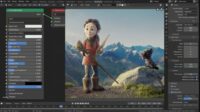
Getting Started with 3D Modeling Software: A Step-by-Step Tutorial
Introduction
3D modeling software has become an indispensable tool for designers, engineers, architects, and other professionals. With its powerful capabilities, you can create realistic 3D models for a wide range of applications, from product design to architectural visualization.
If you’re new to 3D modeling, getting started can seem daunting. However, with the right guidance and a bit of practice, you can quickly master the basics and start creating your own amazing 3D models. This step-by-step tutorial will walk you through the essential steps of getting started with 3D modeling software.
Step 1: Choose 3D Modeling Software
The first step is to choose the right 3D modeling software for your needs. There are many different software options available, each with its own strengths and weaknesses. Popular choices include:
- Blender: A free and open-source software that is suitable for beginners and experienced users alike.
- Autodesk Maya: A professional-grade software with a wide range of features and tools.
- SolidWorks: A software specifically designed for engineering and product design.
- SketchUp: A user-friendly software that is ideal for architectural modeling and design.
Consider your budget, skill level, and the specific applications you will be using the software for when making your choice.
Step 2: Understand the Interface
Once you have installed the software, take some time to familiarize yourself with the interface. Most 3D modeling software have similar layouts, with a main viewport where you create and edit models, along with various toolbars and panels.
Step 3: Create a New Model
To start a new 3D model, create a new project and scene. Your software will provide a default object or shape to start with.
Step 4: Learn Basic Modeling Techniques
The next step is to learn the basic modeling techniques. These include:
- Extrude: Stretching an existing face or edge to create a new shape.
- Bevel: Creating a smooth edge between two surfaces.
- Inset: Moving an edge or face inward to create a recess.
- Cut: Removing a section of a model.
- Boolean Operations: Combining or subtracting shapes to create complex geometries.
You can use these techniques to create a wide range of basic shapes and forms.
Step 5: Add Details and Textures
Once you have the basic shape of your model, you can add details and textures to make it more realistic. You can use specialized tools for adding textures, bump maps, and other surface details.
Step 6: Lighting and Rendering
The next step is to add lighting to your scene. Lighting is crucial for creating realistic-looking models. You can use different types of lights, such as point lights, spotlights, and area lights, to achieve the desired effect.
Once you have added lighting, you can render your model. Rendering is the process of creating a 2D image from your 3D model. Different rendering engines provide varying levels of realism and detail.
Step 7: Export Your Model
When you have finished creating your model, you can export it in a variety of formats, such as STL, OBJ, or FBX. This allows you to share your model with others or use it in other software applications.
FAQ
Q: What is the best 3D modeling software for beginners?
A: Blender is a free and open-source software that is suitable for beginners and experienced users alike. It has a user-friendly interface and a wide range of features and tools.
Q: How long does it take to learn 3D modeling?
A: The time it takes to learn 3D modeling depends on your skill level and the complexity of the models you want to create. You can learn the basics in a few hours, but it can take months or even years to master the software and create professional-grade models.
Q: What are the job opportunities for 3D modelers?
A: 3D modelers are in high demand in a variety of industries, including entertainment, manufacturing, architecture, and engineering. They can work as freelance artists, in-house designers, or as part of a larger team.
Reference
- Blender Official Website
- Autodesk Maya Official Website
- SolidWorks Official Website
- SketchUp Official Website
Conclusion
Getting started with 3D modeling software can be a great way to expand your skills and create amazing 3D models. By following the steps outlined in this tutorial, you can quickly master the basics and start creating your own unique 3D models. With practice and dedication, you can become a proficient 3D modeler and achieve your creative goals.


